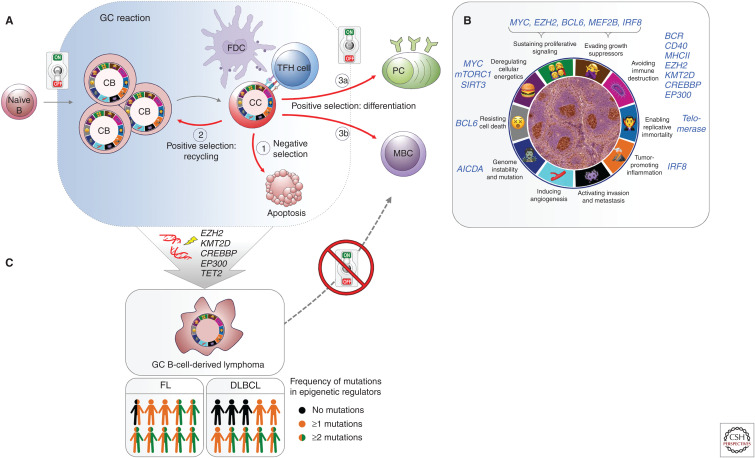Figure 5.
Vulnerable points of germinal center (GC) B cells that give advantage to lymphomagenesis. (A) Chromatin-based epigenetic switches transiently poise the active plasma/memory B-cell program to enable the GC phenotype to emerge in a reversible manner. Cell fate decisions during a normal GC reaction: (1) negatively selected centrocytes (CC) undergo apoptosis; positively selected centrocytes may (2) recycle to centroblast (CB) and reenter the dark zone, or (3) differentiate to (3a) plasma cells (PC) or (3b) memory B cells (MBC). (B) GC B cells feature the typical hallmarks of transformed cells through epigenetic mechanisms, without requiring somatic mutations. This “pseudo-malignant” state can be reversed to normal state also through epigenetic switching mechanisms. (Sketch adapted from Hanahan and Weinberg 2011.) An immunohistochemistry (IHC) picture of GCs identified with peanut agglutinin (PNA) stain in a murine splenic section is shown in the middle. (C) Mutations in epigenetic modifiers maintain B cells in the GC phenotype, allowing the development of GC-derived B-cell lymphomas. Although mutations of one or more chromatin modifier genes occur within 96% of follicular lymphoma (FL) and ∼70% diffuse B-cell lymphoma (DLBCL) patients, 76% FL, and ∼40% DLBCL cases feature at least two mutations in epigenetic regulators (Green et al. 2015; Ortega-Molina et al. 2015; Reddy et al. 2017; Chapuy et al. 2018; Schmitz et al. 2018).

